How to Start a Thrift Store: Idea to Online Success
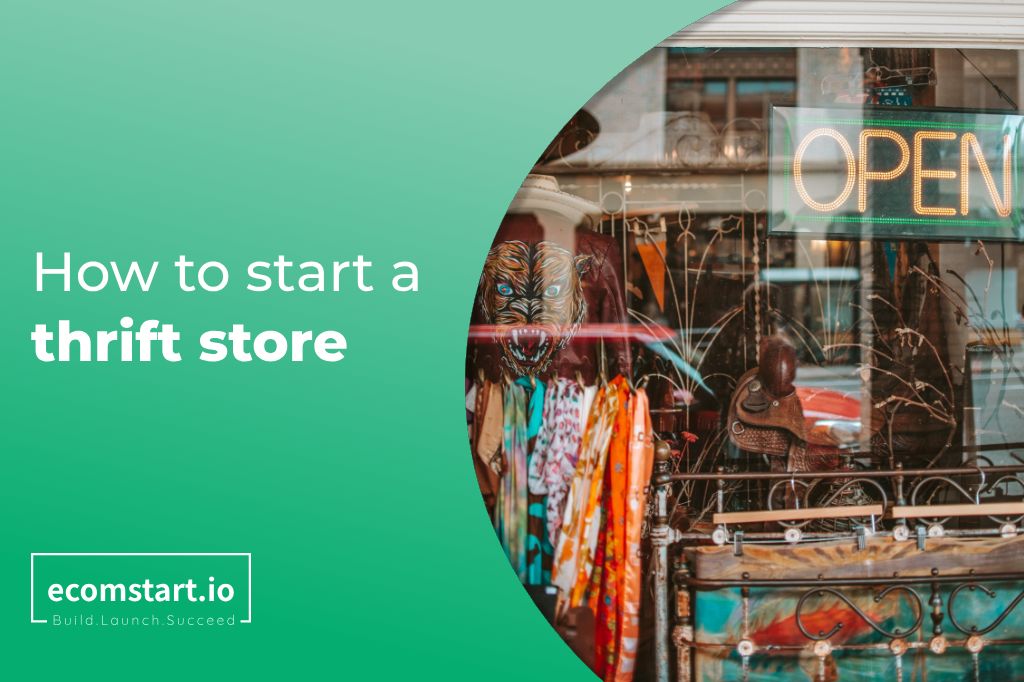
Did you know that the global market value of pre-owned apparel was $177 billion in 2022 and is predicted to double in the next five years, reaching $351 billion by 2027. Hence, the idea of launching a thrift store still sounds like a potential and lucrative deal you should definitely consider.
With that being said, learning how to start a thrift store has never been an easy task. You must find the right niche, build your branding, source products, set up your store, and there, the list goes on.
But don’t worry! Magestore’s commerce experts have got you covered with a step-by-step guide on how to open a thrift store without the headaches!
1. What is a thrift store?
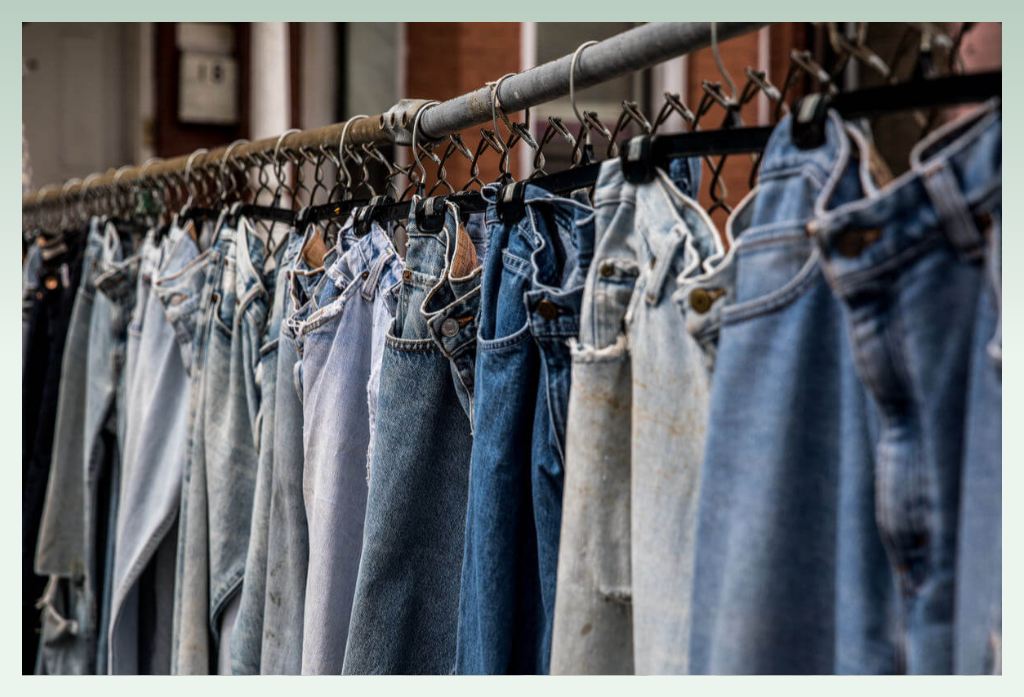
A thrift store is a store selling secondhand items that are gently used, like clothing, furniture, books, household products, etc., at lower prices than typical retail outlets. Usually, these items are largely sourced from donations, estate sales, community drives, and even overstock from retailers. (we’ll discuss how to source products for a thrift store below)
Why do customers love thrift store shopping?
Thanks to its affordability, thrift store is a go-to choice for many customers who want to be smart with their spending. But that’s not the sole reason why nowadays customers gravitate toward secondhand items. Indeed, many customers choose to buy from thrift stores to reduce waste, minimizing their impacts on the environment.
Evidently, according to the survey by IFM and Première Vision on 5,000 respondents in France, British, Germany, Italian, and America, lots of environmentally conscious shoppers have turned to thrift stores instead of traditional ones.
Why should you start an online thrift store?
If you’re dead set on starting a business, here are the top three reasons why an online thrift store can make a brilliant idea:
- As we mentioned earlier at the beginning of this blog– the secondhand market has fantastic potential and is predicted to nourish in the upcoming years.
- Starting an online store means you don’t have to worry about the excruciating costs of operating a physical store, like rentals, utilities, etc.
- Due to the borderless nature of eCommerce, you unlock access to a much broader customer base without being confined to your local community.
But is selling thrifted clothes profitable? Well, with passion, dedication, and proper steps, starting a thrift store can earn you a six-to-seven-figure income. Hence, let us walk you through the detailed steps needed on how to start an online thrift store.
2. How to start an online thrift store in 8 steps
You might think that selling secondhand items sounds like a lucrative idea to make easy money. Nevertheless, the opposite is true. Making an actual profit from your online thrift store requires patience and, most importantly, taking the right steps stone-by-stone.
But don’t worry! The process of how to start a thrift store business isn’t that complicated. As long as you strictly follow the eight steps we’ve prepared below, you should be doing just fine!
2.1. Research and find your niche
Firstly, carefully research and find a niche where your online thrift store will most likely thrive. From our experience, here are the four tips to help you choose a niche properly:
- Trust your guts: You are unlikely to succeed with a niche you know nothing about. So, jot down all the products you are most passionate about and have in-depth knowledge of.
- Research the market trends: With a few niches in mind, use Google Trends or SEO tools like SEMrush, Ahrefs, etc., to understand better what kinds of products your customers lean toward.
For instance, by using Google Trends, we found out that US customers are more interested in secondhand books than shoes over the past 3 months.
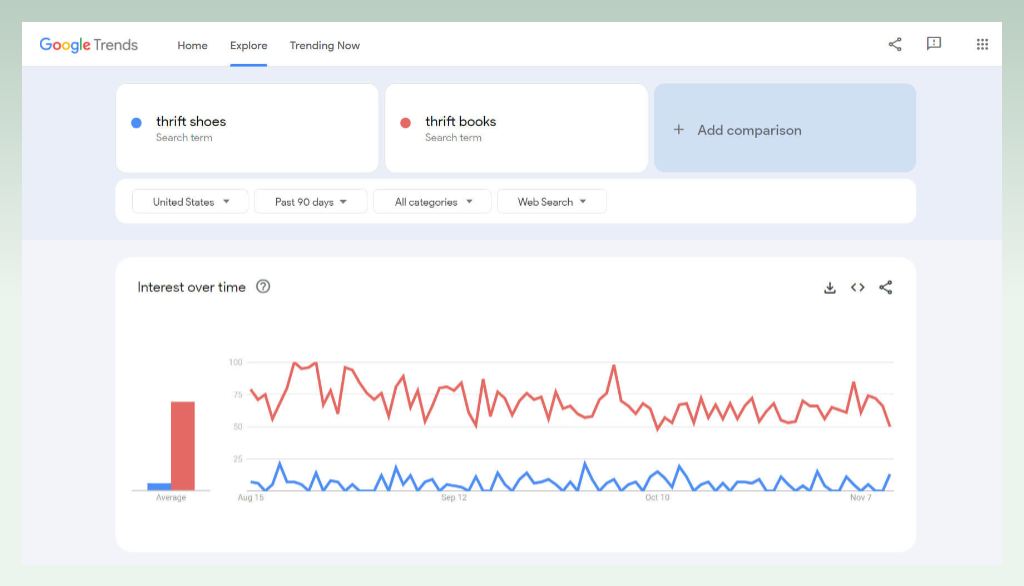
- Prioritize products with scarcity: Per analysis of the effects of product scarcity, customers value scarce products more than abundant ones. Hence, let’s keep narrowing down your options by prioritizing scarcer niches.
- Experiment and validate: One perk of starting an online thrift store is that you can start small and scale up what works later. Hence, we suggest testing your products via major ad platforms like Google or Facebook to understand your customers’ demands and attitudes before investing in a large catalog.
For instance, here are the top five niches for online thrift stores you should consider:
- Clothes: clothing items are always in demand, and many customers are crazy about hunting unique pieces from thrift stores to enrich their collections.
- Shoes: like clothing, secondhand footwear is a no-brainer choice
- Physical books: Though ebooks are gaining increasing popularity these days, physical books, preowned ones, particularly, are all the rage in the second-hand market.
- Electronics: If you have deep knowledge about electronics and know where to source products, electronics can be a high-margin niche to get started.
- Household items: Just like apparel or footwear items, household items will never be out of fashion. Hence, starting an online thrift store selling these products can also be a fantastic idea.
2.2. Create your brand
After picking a niche, the next thing to do is build your brand identity. A strong, effective brand identity will help customers recognize you in the wild and keep you on top of mind amid thousands of eCommerce thrift stores they come across.
Here are two most important questions to put your thoughts into:
- Who is your target audience? Clearly define your potential customers in terms of age, gender, interests, preferred buying channels, etc. The clearer your customer portrait is, the more likely you can tailor your brand message and offerings in ways that resonate with them.
- What are your unique selling points (USPs)? Think of the values you are most proud of, those that set you apart from your competitors– whether it’s sustainability, curated vintage pieces, or affordability and quality.
After figuring out your target audience and USPs, just build your brand around these two X factors. This includes your business name, logo, visual assets, and the brand tone you use to communicate with your customers.
2.3. Source your products
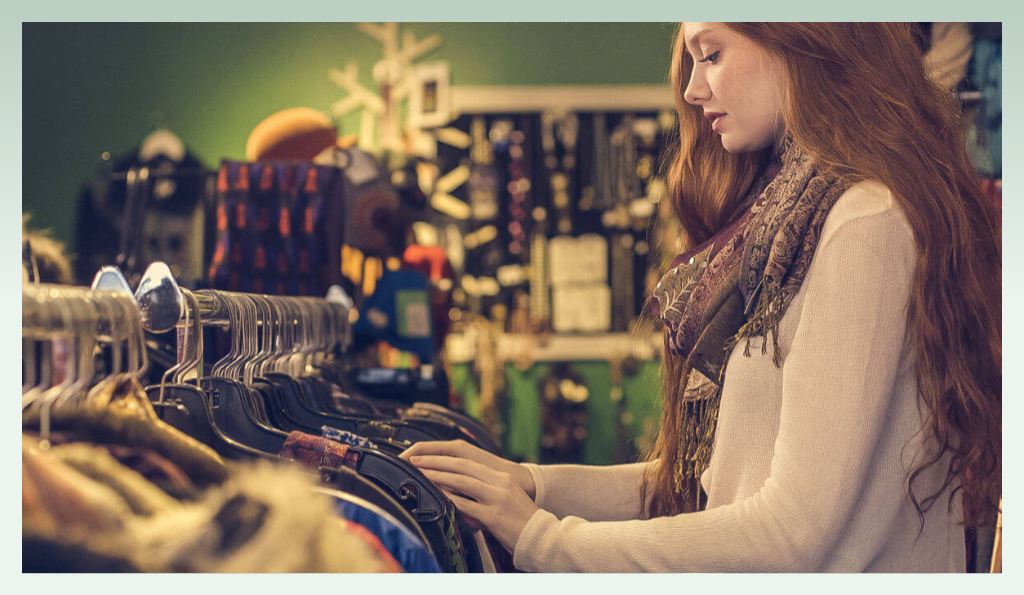
Now that you have pinpointed your niche and established your brand identity, here comes the most important part– sourcing products for your online thrift store.
We’ve wrapped up below some common sources with their pros and cons for your reference:
| Source | Pros | Cons |
| Donations | – It’s cost-effective – Various styles and types of merchandise | – The cost can be higher. – Takes time to sort and sift through the merchandise. |
| Retailers’ clean-outs | – You get to buy items in large quantities. – You could find valuable and unique items. | – The cost can be higher. – Takes time to sort and sift through the merchandise. |
| Garage Sales / Yard Sales / Estate Sales / Flea Markets | – Possibility to find unique items. – Often possible to negotiate prices. | – It can be time-consuming to explore various sales to find enough inventory. – Quality and variety of items vary. |
| Marketplaces like Craigslist, eBay, Amazon, etc. | – Access to large volumes of items. – You can purchase from the comfort of your home. | Condition and quality can be unpredictable. |
| Second-hand Stores / Thrift Stores/ Charities | – Variety of items is generally good. – Charitable organizations often sell items at lower prices. | – Higher competition for quality items, especially in larger urban areas. – Sometimes stores’ prices can be high. |
| Consignment | – No upfront costs for the items as you pay the consignor only after the item sells. – Provides fresh inventory on a regular basis. | – Can be complex with a need for a high level of organization and record keeping. – You’ll make less profit per item, as you need to share the sales revenue with the consignor. |
| Friends and families | – Items could be purchased inexpensively or even given for free. – More trust in knowing the history and condition of items. | – Limited inventory. – Must be careful to maintain healthy relationships when doing business with your loved ones. |
Each source comes with its pros and cons. Also, unlike traditional online stores, product sourcing for thrift stores can get a bit more challenging. Hence, we suggest constantly looking and diversifying your sources to get abundant items for your online thrift store.
2.4. Set up your thrift shop

After finding your product sources – the next thing to do on how to start a thrift store online is to set up your store. You can list your secondhand products on marketplaces like Etsy, eBay, etc., or create your own eCommerce website as you wish.
Sell through marketplaces
If you want to make the best use of the extensive customer base of marketplaces, then you can operate your thrift store on Amazon, Etsy, or eBay. These marketplaces provide you with wide customer reach and are often simple to navigate, making product listing and management relatively easy.
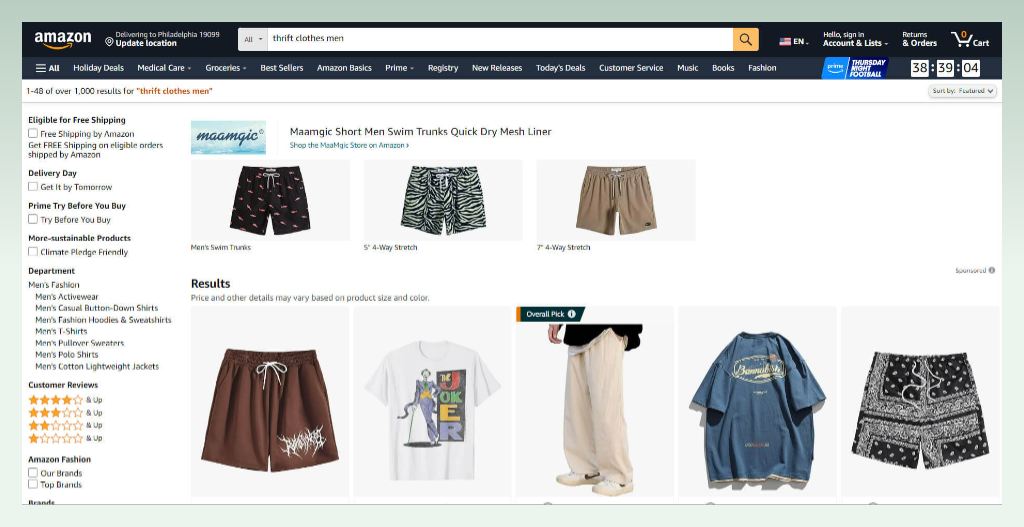
However, it is well noted that platforms like Amazon or eBay are crowded with competitors. Also, the listing fees and commissions can eat into your profits. Plus, you also have less control over branding and customer experiences.
Sell via your own eCommerce website
If you don’t want to deal with tons of fees associated with listing your products on marketplaces and want more control over your storefront, we advise you to build your own eCommerce website.

Suppose you want to launch an online thrift store without technical headaches, Shopify is highly recommended thanks to its ease of use and robust built-in eCommerce features.
Meanwhile, if you want to build a bespoke eCommerce experience for your customers with limitless customization, you should launch a Magento store to prepare your online thrift shop for success.
2.5. Price your products
Next up, work on your product pricing. This is one of the most important steps in today’s list, as your pricing directly impacts your sales, conversions, and profit margins. Here are some of our ideas in case you don’t know where to start yet:
- Determine the cost you incurred to acquire the product, which includes purchase price, finding cost, transport cost, and any other processing cost.
- Account for all operational costs; these can include listing fees, shipping, packaging, and handling of potential returns.
- Consider the costs of listing your products (for marketplaces) or hosting your eCommerce websites (for eCommerce platforms like Shopify, Magento, or WooCommerce).
- Research the price range of similar products in similar conditions on different platforms to have a better hang of your competitors’ prices.
- Take into account the condition, branding, and any unique attributes. If you believe your products are rare or in excellent condition, don’t be shy to aim for a higher price.
2.6. Prepare your product listings

With online shopping, your customers can neither touch and feel your products on their hands nor try them on. Hence, your product listings can be a deal maker or a deal breaker.
And that’s why you need to put some effort into crafting your product listings– whether you list them on marketplaces or your own web store. Here are a few tips to get you started:
- Use natural lighting paired with a plain background to best showcase your product details from multiple angles.
- Use descriptive language to highlight your product’s unique features, condition, and brand.
- Optimize your product description for search engines by using relevant keywords.
- If you sell secondhand clothing items, provide precise measurements to help ease up your customer buying journey, improving your conversions.
- Since you’re selling preowned items, make sure you mention flaws or imperfections (if any) in your product description to maintain transparency.
2.7. Create a marketing plan
Now that you have well-crafted product listings and set up your online store– let’s create a well-thought-out marketing plan to promote your thrift shop.
- Paid ad campaigns: If you just get started with no branding yet, paid ad campaigns are the most powerful weapon to promote your thrift store. Choose the ad platforms that align with your customer portrait and marketing goals. For instance, if you target Gen-Z, ad channels like Instagram, Facebook, or TikTok will be more effective than others.
- Social media marketing: Hosting giveaway contests on platforms like Instagram or Facebook can help amplify your brand awareness and drive qualified traffic to your thrift store. Plus, consider collaborating with influencers on TikTok or Instagram to boost your sales.
- Search engine optimization: Don’t forget to put an SEO plan in mind if you want to grow your online thrift store sustainably. For instance, you can write SEO-friendly, insightful blog posts to attract organic traffic to your thrift store. Also, remember to optimize your website for speed and mobile devices, as speed and responsiveness are also Google’s key ranking actors.
2.8. Sort out all legal documents
Last but not least, don’t forget to legalize your business by sorting out all the necessary legal documents. Of course, the required documents will vary depending on your country. However, typically, you’ll need to sort these legal documents out:
- Business license: Most countries require businesses to be licensed in order to operate legally within certain jurisdictional limits.
- EIN Number: Your Employer Identification Number (EIN) is a nine-digit number assigned by the IRS to identify taxpayers required to file various business tax returns.
- Trademark registration: If you have a unique brand name or logo, you may choose to protect it by registering it as a trademark.
- Seller’s Permit or Resale Certificate: This is usually required if you sell goods subject to sales tax.
- Certificate of Incorporation or LLC Forms: If you decide to incorporate or form an LLC for your business, you must file incorporation papers or LLC forms with your Secretary of State’s office.
3. Mistakes to avoid when starting an online thrift store
When starting an online thrift store, there are certain mistakes you need to avoid at all costs. Most people will learn these mistakes the hard way. But luckily, you don’t have to, as we’ve already listed them down below!
- Undervalue your products. Even if your products are second-hand, their value shouldn’t be diminished, especially if they are in good condition or vintage. For example, a designer bag could still retain a high value even if it’s used.
- Uploading sub-quality product images. Poor-quality product images might scare your customers away. So, ensure your product photos are clear and showcase your products in the best light possible.
- Ignoring your navigation. Website navigation is of extreme importance since your customers will leave if they feel like they are getting lost on your site. Hence, put some effort into your site navigation.
- Disregarding legalities. Always obtain necessary permits and licenses, secure your store’s privacy policy, and accurately report your income to avoid legal issues down the line. Otherwise, it will lead to some severe consequences.
4. Tips for a successful online thrift store launching
To help simplify your way to success, we’ve prepared here some battle-tested tips that no one told you about!
- Aim to stock unique items that are not easily found elsewhere, yet ensure they are of good quality. Second-hand should not mean second-best, so avoid selling overly worn or damaged items.
- Optimize your website with user experience in mind. Otherwise, your store won’t be able to convert well. For instance, implement user-friendly search filters, quick-loading pages, and uncomplicated checkout processes.
- Work on your product listings. Your product photos should be of the highest quality and capture various angles. Also, your descriptions should be precise, highlighting key details like measurements, material, and item condition.
- Invest time in crafting an effective shipping and return policy to instill more confidence in your customers.
- As acquiring a new customer is six times more expensive than retaining one. Hence, you might want to run a loyalty program to boost your customers’ repeat purchases. For instance, you can incentivize your shoppers to spend more and accumulate points– which they can redeem for sweet offers. A best POS system for consignment store can help automate this process by tracking customer purchases, managing points accrual, and sending personalized offers or reminders, making it easier to build long-term customer relationships.
5. Best online thrift stores in 2023 for your inspiration
The best way to learn is by learning from the best. Therefore, we have collected and curated the three best online thrift stores for your inspiration.
5.1. ThredUP
First up, we have ThredUP– the world’s largest online thrift store that sells high-quality preowned clothing from popular brands at bargain prices. What makes ThredUP so popular is that they meticulously inspect each item to ensure that everything listed in their thrift store meets the highest quality standards.
ThredUP’s website is pretty user-friendly and well-organized, allowing customers to filter their search and find their way to the desired items easily.
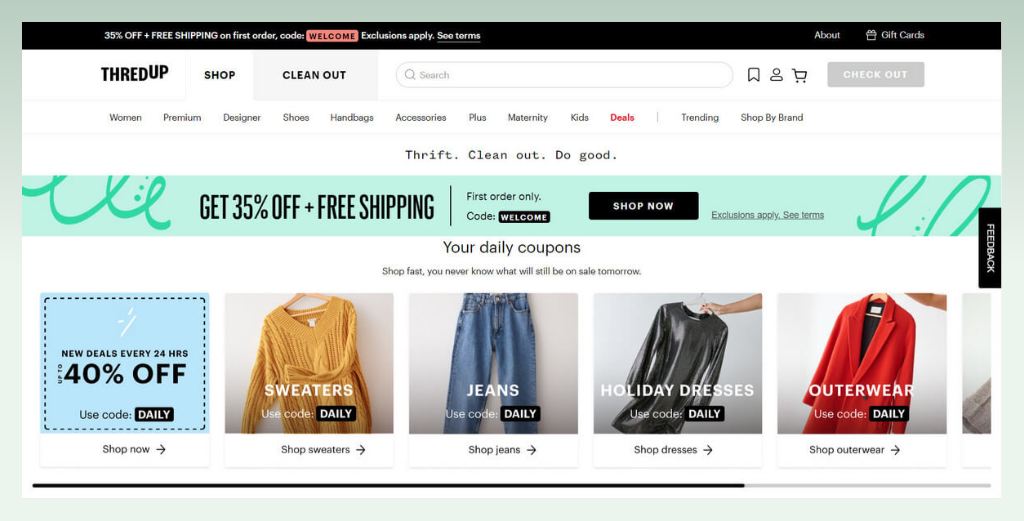
5.2. The RealReal
If you truly want some inspiration, take a look at The RealReal– an authenticated luxury consignment-based thrift store. The RealReal sets itself apart by selling exclusively preowned high-end brands and designer items, each meticulously authenticated by its in-house experts. From clothing and accessories to home decor, The RealReal provides a sustainable, trusted, and luxurious avenue for pre-loved goods.

5.3. Depop
Depop is an innovative online thrift store with a strong emphasis on trend-driven, vintage fashion, and unique items we think you might want to learn from. The website has a social-media-inspired interface aimed at younger, millennial, and Gen-Z shoppers.
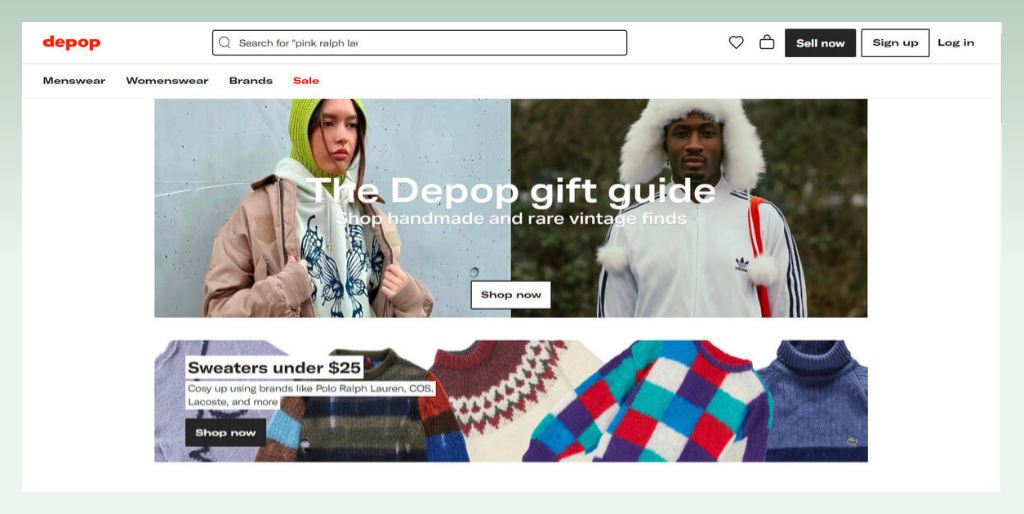
6. Conclusion
Amid the economic recession we’re facing and customers’ shifting attitude toward sustainable practices, now is the right time to launch an online thrift store. However, if you are serious about doing business, you must know that starting one has never been easy. That’s why we hope our detailed guide on how to start a thrift store can help you gain some valuable insights if you don’t know where to get started yet.


